For “Travel Tuesday” let’s go down to South Padre Island:
South Padre Island
“South Padre Island offers excursions for anyone looking to get away for a quick or extended vacation. Located on the tropical tip of Texas, The Island is bordered by the Gulf of Mexico and the Laguna Madre Bay, and its only link to the mainland is the 2 1/2 mile Queen Isabella Memorial Bridge.  The 34 mile-long barrier reef is about a 1/2 mile at its widest point and has about 5,000 inhabitants and about one million visitors annually. Streets are bustling with retail shops, resort hotels, condominium towers, restaurants and recreational activities. This little slip of land was initially named "Isla Blanca" or "White Sand" when it first charted in 1519 by Spanish explorer Alonzo de Pineda. In 1804, missionary priest Jose Nicholas Balli established the first settlement after the initial grant was made by Spain's King Charles IV. It was incorporated in 1973, and the bridge was completed a year later. The Island is a year-round vacation destination, because it enjoys a sub-tropical climate. Jacketless winters have an average temperature of 65 degrees; breezy summers have an average temperature of 82 degrees; and there is an average of 253 days of picturesque sunshine.
The 34 mile-long barrier reef is about a 1/2 mile at its widest point and has about 5,000 inhabitants and about one million visitors annually. Streets are bustling with retail shops, resort hotels, condominium towers, restaurants and recreational activities. This little slip of land was initially named "Isla Blanca" or "White Sand" when it first charted in 1519 by Spanish explorer Alonzo de Pineda. In 1804, missionary priest Jose Nicholas Balli established the first settlement after the initial grant was made by Spain's King Charles IV. It was incorporated in 1973, and the bridge was completed a year later. The Island is a year-round vacation destination, because it enjoys a sub-tropical climate. Jacketless winters have an average temperature of 65 degrees; breezy summers have an average temperature of 82 degrees; and there is an average of 253 days of picturesque sunshine.
City and County Beaches
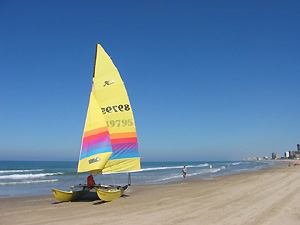
Location: East side of Island. Directions: There are public beach access points every couple of blocks. Turn off of Padre Blvd. on any cross street to get to Gulf Blvd.and park at one of the public beach access points to get to the city beaches. Or visit one of the county beach parks on the southern or northern ends of the Island.
There are no privately owned beaches in Texas, so everyone is welcome to enjoy every inch of the entire coast line.
There are beach access points every few blocks along Gulf Blvd, or you can go to one of the county park beaches where you'll find pavilions with picnic tables, playgrounds, restrooms, and showers.
Travel Channel names South Padre Island as one of America's best beaches for family beach travel. When summing up America's best beaches, the Travel Channel says "Calling all soccer moms: It's time to kick off your work pumps and throw on your flip-flops. Treat yourself to a relaxing day at the beach. These kid-friendly beaches are just the place to unwind with the family. Don't worry. While you peacefully soak in the sun, your children will be entertained with plenty of activities on and off the beach. South Padre Island is perfect for vacationing families and honeymooners. This beach is for the value-conscious traveler."
Just remember to please leave only your footprints in the sand. The beaches of South Padre Island are the number one attraction for many Island visitors.
What to Do
South Padre Island's beaches serve as the perfect relaxation backdrop for a tanning session, reading your favorite novel or sipping a frosty cocktail, but there are activities to feed an adventurist's hunger. Kiteboarders and windsurfers dance through the Island's waves as others parasailing glide along the blue sky and soak in the moment filled with a breathtaking, postcard-like Island panorama. Others test their skills at surfing, skiing or horseback riding.  Ecotourism is vibrant with dolphin boat trips, birding and sea turtles. The Dolphin and Nature Research Center provides a hands-on encounter with the Gulf's inhabitants and stresses the significance of conservation.
Ecotourism is vibrant with dolphin boat trips, birding and sea turtles. The Dolphin and Nature Research Center provides a hands-on encounter with the Gulf's inhabitants and stresses the significance of conservation.
With more than 306 recorded bird species, the Island has become one of the premier birding locations in the Western Hemisphere. Historic Port Isabel is located just over the bridge. It offers much of the same recreational activities. This quaint fishing village is home to the Point Isabel Lighthouse where tourists can catch a bird's-eye view of the Gulf and Laguna Madre Bay. Tours are available from the Island to the dynamic border town of Matamoros located just 30 miles to the south. For less than an hour drive, tourists can shop for native crafts and please palates with authentic Mexican cuisine. The Island is also a hotspot for retirees from northern regions seeking warmer weather. These residents are known as "Winter Texans."
Location, Location, Location
The Queen Isabella Memorial Causeway.
It is a hotspot for retirees from northern regions to stay throughout the winter months. These residents are known throughout the Rio Grande Valley as "Winter Texans." One of the best kept secrets in Texas has finally been revealed and the value of this jewel has been made known. It is a unique setting that lures people to return again and again to enjoy the spirit of adventure that can be found there. South Padre Island is a year-round vacation destination located at the same latitude as Fort Lauderdale, Florida. The Island enjoys a sub-tropical environment with mild dry winters, and warm breezy summers. With a winter average temperature of 65 degrees, a summer average temperature of 82 degrees and and an average of 253 days of beautiful sunshine, it's no wonder why so many people love South Padre Island.
Seaweed, formally known as sargassum, is as common as wanting to visit South Padre Island

Seaweed has never been very popular and most people would just as soon not see it during their beach time.
South Padre Island realizes the critical importance seaweed has for our environment. First, as a naturally occurring activity, its appearance is a normal part of beach life. Secondly, the seaweed traps and keeps sand in place, helping to slow down beach erosion. Seaweed also allows dunes to revegetate and strengthen by adding nutrients to the system used by dune vegetation.
The dune system provides storm protection, habitat restoration and assists in the economic growth of our area.
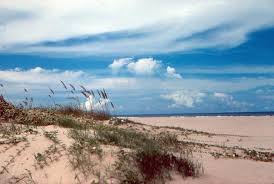 Mother Nature has done a great job with South Padre Island. When it comes to the dunes and seaweed, the City of South Padre Island tries to give a little assistance. We try to limit raking of seaweed to times when there is a significant amount on the beach. Anything that is raked is reused in parts of the dune system.
Mother Nature has done a great job with South Padre Island. When it comes to the dunes and seaweed, the City of South Padre Island tries to give a little assistance. We try to limit raking of seaweed to times when there is a significant amount on the beach. Anything that is raked is reused in parts of the dune system.
South Padre Island has been recognized twice in recent years for having one of America’s best restored beaches. So, when you see some seaweed on the beach, remember it is an important part of our environment: as natural as your desire to keep returning to South Padre Island!”
______________
Sand Dunes and Empty Beaches
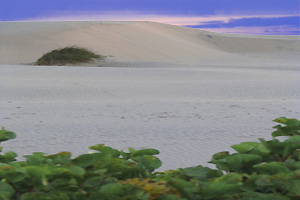 “Location: North of City Limits.
“Location: North of City Limits.
Directions: Drive north on Padre Blvd. to beach access #5 or #6. Head north on the beach to find your secluded getaway. 4 wheel drive is highly recommended, but on low tide 2wd access is possible. If you don't want to drive on the sand, then go to the end of Park Road 100, it dead ends in the middle of tall sand dunes with a great view of the bay and surf. Nice place to watch the sunrise or sunset, or take the kids to romp in the dunes.
Padre Island, the longest undeveloped barrier island in the world, stretches for 110 miles along the Texas Gulf Coast. The national seashore occupies miles of uninhabited island paradise, a place where sandy beaches are met by the warm and gentle waters of the Gulf of Mexico. Padre Island is named for Padre Jose Nicolas Balli, who built a mission on the island in the early 1800s to Christianize the native Karankawa Indians.
The sand dunes north of city limits is the perfect getaway if you are looking for your very own private stretch of beach. Camping is allowed and free. Driving is allowed on the beach, you can drive nearly 30 miles on the sand until the Port Mansfield jetties. Four wheel drive vehicles are recommended for driving on the sand, otherwise you can drive to the end of the paved road, Padre Blvd, and climb up one of the tall sand dunes that borders the national seashore, where you have a stunning view of both the bay and Gulf. It is a great place to enjoy our beautiful sunsets over the Laguna Madre, sunrise over the surf, and a perfect spot to relax and look at the stars. This is a highly recommended activity for kids!” More at: http://www.spadre.com/attractions.htm
___________
The Four Lives of a Ghost Ship
“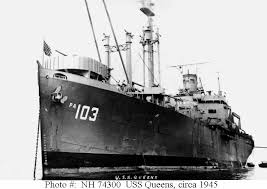 The Texas Clipper was commissioned by the US Navy as the USS Queens (APA-103) in December 1944. During World War II (WWII), she was used as a troop transport ship into the South Pacific and as a floating hospital and transport after the battles in Iwo Jima. Before being decommissioned in 1946, the Queen was also part of an American occupation in Japan.
The Texas Clipper was commissioned by the US Navy as the USS Queens (APA-103) in December 1944. During World War II (WWII), she was used as a troop transport ship into the South Pacific and as a floating hospital and transport after the battles in Iwo Jima. Before being decommissioned in 1946, the Queen was also part of an American occupation in Japan.
In 1948, the Clipper’s name was  changed to the S.S. Excambion; and from 1948 to 1959, she served as one of the post-war four aces for the American Export Lines. The original Four Aces were ocean liners that routinely crossed the Atlantic to various ports in the Mediterranean. But when WWII broke out, these ships were sold to the US Navy and converted to troop transports. Unfortunately, three of these ships sank in battle including the original S.S. Excambion. To replace the lost vessel, the American Export Lines purchased the USS Queens and quickly converted her to a cruise liner to continue their business abroad.
changed to the S.S. Excambion; and from 1948 to 1959, she served as one of the post-war four aces for the American Export Lines. The original Four Aces were ocean liners that routinely crossed the Atlantic to various ports in the Mediterranean. But when WWII broke out, these ships were sold to the US Navy and converted to troop transports. Unfortunately, three of these ships sank in battle including the original S.S. Excambion. To replace the lost vessel, the American Export Lines purchased the USS Queens and quickly converted her to a cruise liner to continue their business abroad.
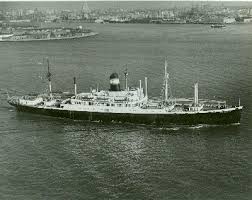 Once her service with the American Export line ran its course, the S.S. Excambion lay at anchorage in the Hudson River Ready Reserve Fleet for seven years. It was not until 1965 when the next phase of her life was determined when the federal government lent the Excambion to the Texas Maritime Academy. Once at the Academy she was renamed the U.S.T.S. Texas Clipper; and from 1965 to 1996 she spent summers at sea providing an educational experience to hundreds of students.
Once her service with the American Export line ran its course, the S.S. Excambion lay at anchorage in the Hudson River Ready Reserve Fleet for seven years. It was not until 1965 when the next phase of her life was determined when the federal government lent the Excambion to the Texas Maritime Academy. Once at the Academy she was renamed the U.S.T.S. Texas Clipper; and from 1965 to 1996 she spent summers at sea providing an educational experience to hundreds of students.

The Reefing

The Texas Clipper was reefed on November 17, 2007, 17 miles off South Padre Island. The location of the site was selected because of the depth it could provide above her highest most feature and because it would offer clear water for divers most of the year. The reef site is located in federal waters in the western portion of the Gulf of Mexico. The ship was placed at a depth of 134 ft giving it a minimum depth of 62 ft.
While at anchorage in Beaumont, the ship had to undergo considerable hull modifications to ensure she met the depth clearance requirements, while also retaining as much of the ship’s original external features as possible. Modifications were also made to ensure divers could make limited penetration through large openings to better provide for their safety. Once the modifications were made and all pollutes removed, the ship was towed to south Texas and eventually the reefing site in November 07.
 The plan was to flood the Texas Clipper in a way to make her bottom heavy which would sink the vessel in an upright position. Unfortunately, as she sank, she filled with water in such a way as to make her port side heavier causing her to land on her port side instead of her keel. If she had stayed upright, her upper most structure would have been relatively shallow at about 50 ft. Because she is on her port side she is just a little deeper at around 62 ft. This is still shallow enough for recreational divers but just a little more disorienting than planned.” From: http://maritimetexas.net/wordpress/?p=367
The plan was to flood the Texas Clipper in a way to make her bottom heavy which would sink the vessel in an upright position. Unfortunately, as she sank, she filled with water in such a way as to make her port side heavier causing her to land on her port side instead of her keel. If she had stayed upright, her upper most structure would have been relatively shallow at about 50 ft. Because she is on her port side she is just a little deeper at around 62 ft. This is still shallow enough for recreational divers but just a little more disorienting than planned.” From: http://maritimetexas.net/wordpress/?p=367
-------------
The Texas Clipper Now
“Texas Parks and Wildlife sank a 7000-ton ship 17 nautical miles off the coast of South Padre Island to create an artificial reef on the barren sandy bottom of the Gulf of Mexico. It has become a haven for marine life, anglers and divers.”
http://www.youtube.com/watch?feature=player_embedded&v=Q97IAUHICjo
“Texas Parks & Wildlife television producer Bruce Biermann, an expert diver, says the sunken Texas Clipper is the best day-trip scuba adventure off the Texas coast. After a colorful career dating back to World War II, the Texas Clipper was sunk in 2006 as part of the Ships-to-Reefs program. In the years since, she has become an enormous oasis for marine life. “I came around the davit arm once and had four of the largest red snapper I have ever seen staring at me,” Biermann says. “Manta ray, amberjacks, barracuda, queen angels, grouper — they all abound on the Clipper. Even shark and dolphin sightings are not unusual.”
 The Texas Clipper is a multilevel dive, meaning experienced, open-water certified divers can explore the A deck and the Promenade at 62 to 80 feet. Penetration divers, experienced with overhead environments, can tackle interior spaces to depths from 70 feet to over 110 feet. Meanwhile, because much of the wreck is more than 60 feet above the bottom it may be explored by entry level divers. We recommend entry level divers consider professionally guided dives.
The Texas Clipper is a multilevel dive, meaning experienced, open-water certified divers can explore the A deck and the Promenade at 62 to 80 feet. Penetration divers, experienced with overhead environments, can tackle interior spaces to depths from 70 feet to over 110 feet. Meanwhile, because much of the wreck is more than 60 feet above the bottom it may be explored by entry level divers. We recommend entry level divers consider professionally guided dives.
The Texas Clipper can be compared to a large museum, requiring scuba divers to make several trips to fully appreciate it because of the size. "The ship is so large you can dive a hundred times and still not see everything."
For more information on the artificial reef program, visit http://www.tpwd.state.tx.us/landwater/water/habitats/artificial_reef/overview...”
____________
On This Day:
Millard Fillmore sworn in as president, Jul 10, 1850:
“On this day in 1850, Vice President Millard Fillmore is sworn in as the 13th president of the United States. President Zachary Taylor had died the day before, five days after falling ill with a severe intestinal ailment on the Fourth of July.
As vice president, Fillmore quietly expressed his support of a compromise in slavery legislation and thus appeared sympathetic to slave-owning interests. However, President Taylor opposed slavery and vowed to use force against southern states who threatened to secede if denied the right to use slave labor. During Fillmore's single term as president, he passed the Fugitive Slave Act (1850), which made it a crime to support slaves trying to escape to free territories. He also presided over an era of increased settlement across the western part of the continent. As white settlers clashed with indigenous peoples, Fillmore approved one-sided treaties that forcibly placed Native Americans onto government reservations. During this time, millions of Native Americans died from disease and starvation and in wars with government-funded militias.
After losing the support of his northern anti-slavery constituency, the incumbent Fillmore was defeated by the Democrat Franklin Pierce in the 1852 presidential race. After making two more unsuccessful bids for the presidency in 1856 and 1860, he retired to Buffalo, New York, where he served on various legal and historical committees until his death in 1874.”
__________
U.S. Patent issued for three-point seatbelt, Jul 10, 1962:
“The United States Patent Office issues the Swedish engineer Nils Bohlin a patent for his three-point automobile safety belt "for use in vehicles, especially road vehicles" on this day in 1962.
Four years earlier, Sweden's Volvo Car Corporation had hired Bohlin, who had previously worked in the Swedish aviation industry, as the company's first chief safety engineer. At the time, safety-belt use in automobiles was limited mostly to race car drivers; the traditional two-point belt, which fastened in a buckle over the abdomen, had been known to cause severe internal injuries in the event of a high-speed crash. Bohlin designed his three-point system in less than a year, and Volvo introduced it on its cars in 1959. Consisting of two straps that joined at the hip level and fastened into a single anchor point, the three-point belt significantly reduced injuries by effectively holding both the upper and lower body and reducing the impact of the swift deceleration that occurred in a crash.
On August 17, 1959, Bohlin filed for a patent in the United States for his safety belt design. The U.S. Patent Office issued Patent No. 3,043,625 to "Nils Ivar Bohlin, Goteborg, Sweden, assignor to Aktiebolaget Volvo" on July 10, 1962. In the patent, Bohlin explained his invention: "The object... is to provide a safety belt which independently of the strength of the seat and its connection with the vehicle in an effective and physiologically favorable manner retains the upper as well as the lower part of the body of the strapped person against the action of substantially forwardly directed forces and which is easy to fasten and unfasten and even in other respects satisfies rigid requirements."
Volvo released the new seat belt design to other car manufacturers, and it quickly became standard worldwide. The National Traffic and Motor Vehicle Safety Act of 1966 made seat belts a required feature on all new American vehicles from the 1968 model year onward. Though engineers have improved on seat belt design over the years, the basic structure is still Bohlin's.
The use of seat belts has been estimated to reduce the risk of fatalities and serious injuries from collisions by about 50 percent. In 2008, an all-time high 83 percent of front-seat occupants in the United States buckled their seat belts.”
___________
Yesterday:
Muffie’s Dad called to remind me that it was time for her to have her flea preventative, and so that meant it was time for Maddie’s, too. So Misty and I went down there for her walk-about.
Jay said he wanted to work, so we came back here to work on the cargo trailer.
We went up in my attic to get the handle for the cabinet door, and we could tell the difference up there with just one front soffit vent opened up. I can’t imagine what the contractors were thinking, just screwing the vents over the plywood, without cutting a hole. No wonder my attic couldn’t breathe right!!
We installed the cabinet door in the bed’s bench, and the brass hasp to fasten the table in place.
Then we put the other brass hasp on the bed base, for
There was still a bit of time before I had to take Jay home, so he cut one more hole in the soffit plywood, and replaced that vent, and again he could feel the heat coming out of the attic. Four more to go.
It suddenly started raining again, but we ran between the raindrops and got ‘er done. Then it stopped.
We are NOT complaining after last year, but the grass is getting all wispy again with the rain we have been having the last few days.



















2 comments:
It will be so much better when you get all the vents cut open. The laziness of others create hardships and expense for others.
Thank you for your comment, DD.
Yes, if I can ever get Jay working, instead of drinking, he can cut the rest of them. Neither Ray nor I are tall enough.
When they are all cut out, I am sure it will make a difference in my electric bill. The power attic fan and the turbos will be able to suck the heat out of the attic, when they have somewhere to suck air from.
The contractors were getting paid by submitting pictures of my house, so no one knew what short cuts they had taken. A man, not a contractor, did a quick inspection for the company, but he didn't check anything.
Happy Tails and Trails, Penny
Post a Comment